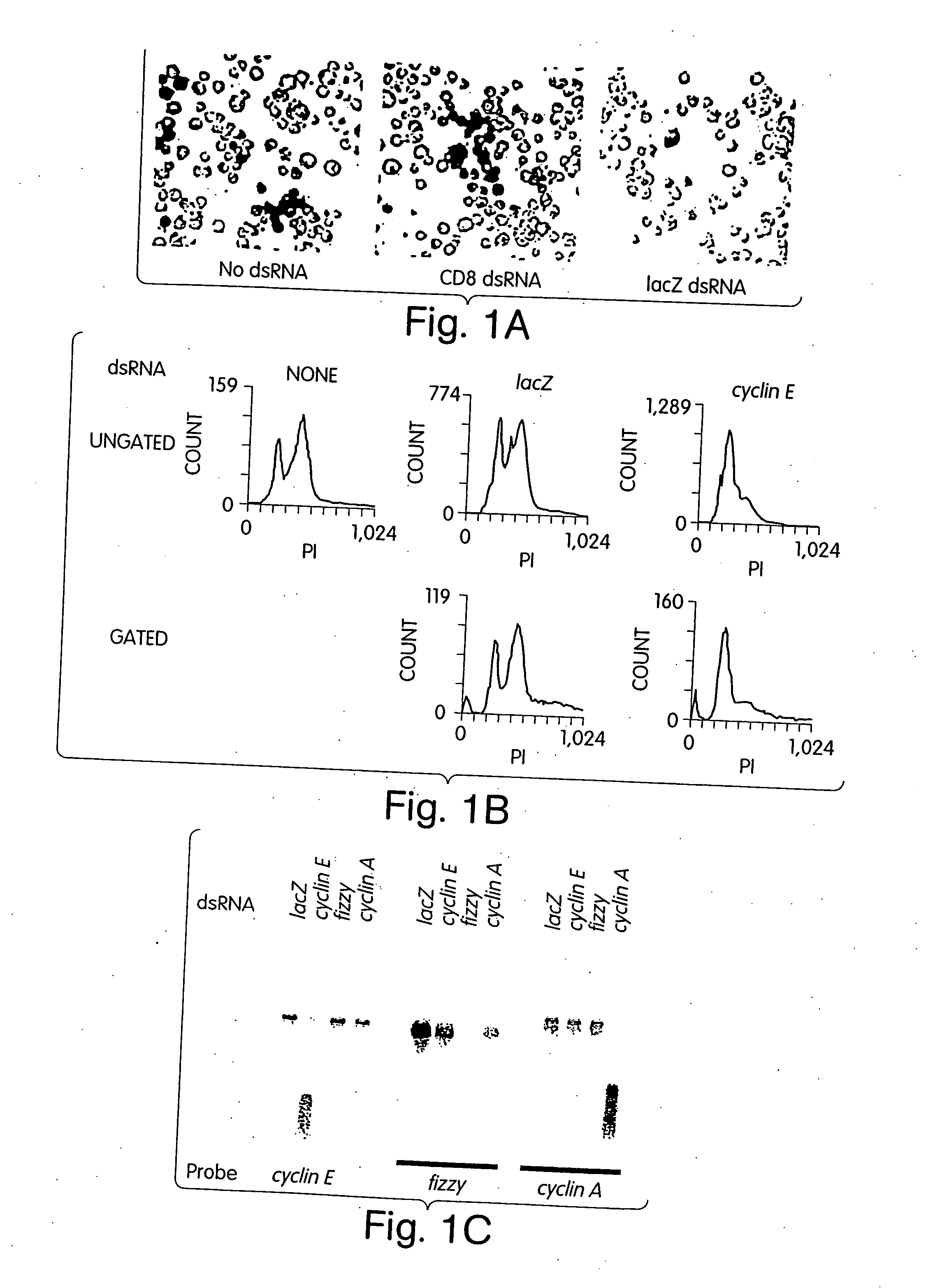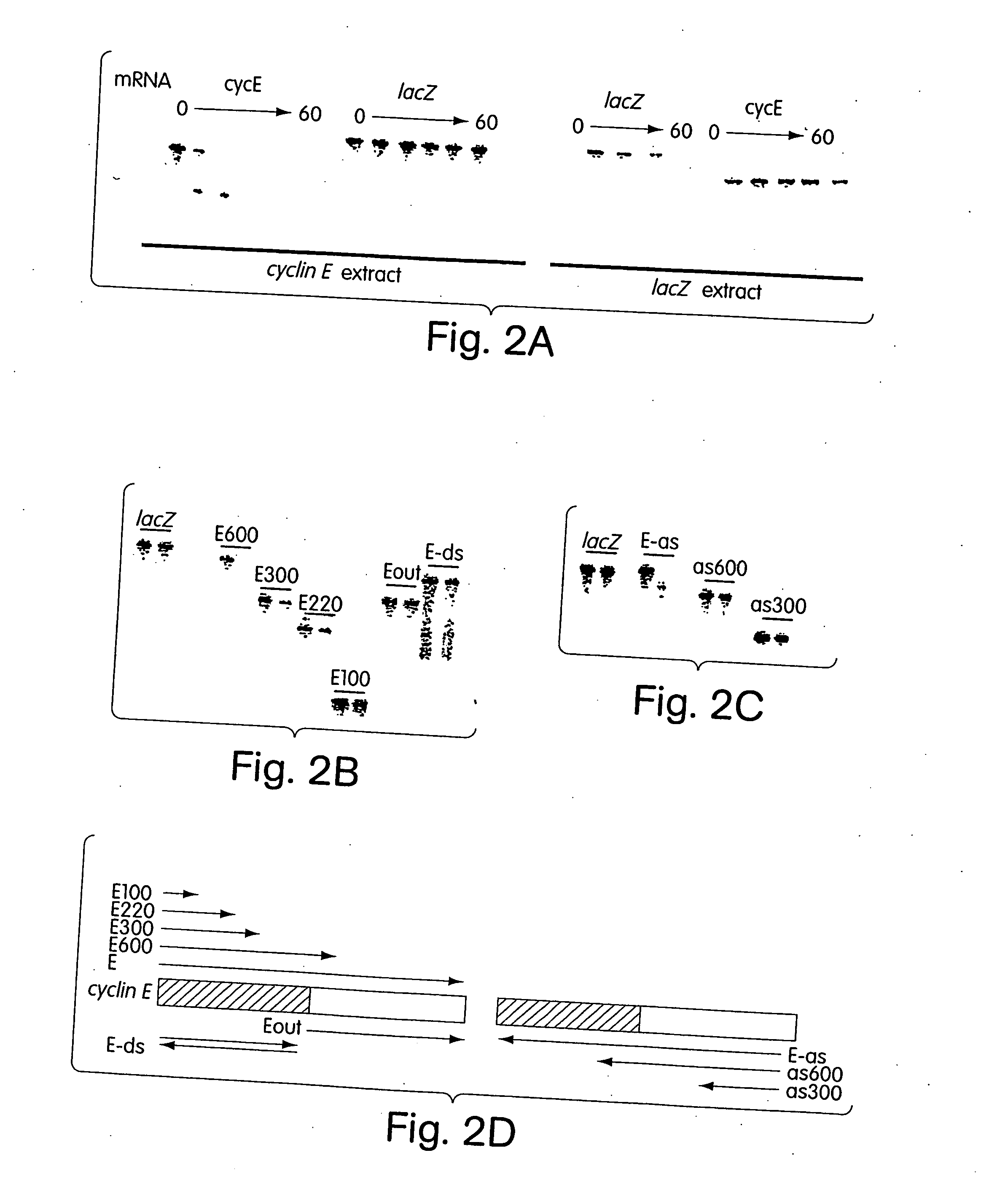Methods and compositions for RNA interference
a technology of rna interference and composition, which is applied in the field of methods and compositions for rna interference, can solve the problems of ineffective reagents for intronic or promoter sequence constructs, and the inability to recapitulate this phenomenon in higher eukaryotes, particularly mammalian cells, and achieves the effect of recapturing the phenomenon in the ar
- Summary
- Abstract
- Description
- Claims
- Application Information
AI Technical Summary
Benefits of technology
Problems solved by technology
Method used
Image
Examples
example 1
An RNA-Directed Nuclease Mediates RNAi Gene Silencing
[0243] In a diverse group of organisms that includes Caenorhabditis elegans, Drosophila, planaria, hydra, trypanosomes, fungi and plants, the introduction of double-stranded RNAs inhibits gene expression in a sequence-specific manner (Sharp, Genes and Development 13: 139-141, 1999; Sanchez-Alvarado and Newmark, PNAS 96: 5049-5054, 1999; Lohman et al., Developmental Biology 214: 211-214, 1999; Cogoni and Macino, Nature 399: 166-169, 1999; Waterhouse et al., PNAS 95: 13959-13964, 1998; Montgomery and Fire, Trends Genet. 14: 225-228, 1998; Ngo et al., PNAS 95: 14687-14692, 1998). These responses, called RNA interference or post-transcriptional gene silencing, may provide anti-viral defense, modulate transposition or regulate gene expression (Sharp, Genes and Development 13: 139-141, 1999; Montgomery and Fire, Trends Genet. 14: 225-228, 1998; Tabara et al., Cell 99: 123-132, 1999; Ketting et al., Cell 99: 133-141, 1999; Ratcliff et a...
example 2
Role for a Bidentate Ribonuclease in the Initiation Step of RNA Interference
[0257] Genetic approaches in worms, fungi and plants have identified a group of proteins that are essential for double-stranded RNA-induced gene silencing. Among these are ARGONAUTE family members (e.g. RDE1, QDE2) (Tabara et al., Cell 99: 123-132, 1999; Catalanotto et al., Nature 404: 245, 2000; Fagard et al., PNAS 97: 11650-11654, 2000), recQ-family helicases (MUT-7, QDE3) (Ketting et al., Cell 99: 133-141, 1999; Cogoni and Macino, Science 286: 2342-2344, 1999), and RNA-dependent RNA polymerases (e.g., EGO-1, QDE1, SGS2 / SDE1) (Cogoni and Macino, Nature 399: 166-169, 1999; Smardon et al., Current Biology 10: 169-178, 2000; Mourrain et al., Cell 101: 533-542, 2000; Dalmay et al., Cell 101: 543-553, 2000). While potential roles have been proposed, none of these genes has been assigned a definitive function in the silencing process. Biochemical studies have suggested that PTGS is accomplished by a multicompon...
example 3
A Simplified Method for the Creation of Hairpin Constructs for RNA Interference
[0275] In numerous model organisms, double stranded RNAs have been shown to cause effective and specific suppression of gene function (Bosher and Labouesse, Nature Cell Biology 2: E31-E36, 2000). This response, termed RNA interference or post-transcriptional gene silencing, has evolved into a highly effective reverse genetic tool in C. elegans, Drosophila, plants and numerous other systems. In these cases, double-stranded RNAs can be introduced by injection, transfection or feeding; however, in all cases, the response is both transient and systemic. Recently, stable interference with gene expression has been achieved by expression of RNAs that form snap-back or hairpin structures (Fortier and Belote, Genesis 26: 240-244, 2000; Kennerdell and Carthew, Nature Biotechnology 18: 896-898, 2000; Lam and Thummel, Current Biology 10: 957-963, 2000; Shi et al., RNA 6: 1069-1076, 2000; Smith et al., Nature 407: 31...
PUM
| Property | Measurement | Unit |
|---|---|---|
| density | aaaaa | aaaaa |
| pH | aaaaa | aaaaa |
| pH | aaaaa | aaaaa |
Abstract
Description
Claims
Application Information
 Login to View More
Login to View More - R&D
- Intellectual Property
- Life Sciences
- Materials
- Tech Scout
- Unparalleled Data Quality
- Higher Quality Content
- 60% Fewer Hallucinations
Browse by: Latest US Patents, China's latest patents, Technical Efficacy Thesaurus, Application Domain, Technology Topic, Popular Technical Reports.
© 2025 PatSnap. All rights reserved.Legal|Privacy policy|Modern Slavery Act Transparency Statement|Sitemap|About US| Contact US: help@patsnap.com



